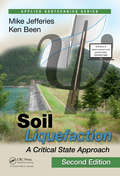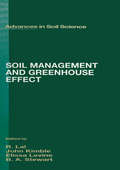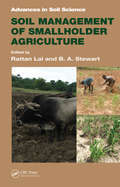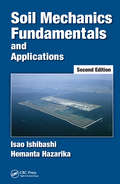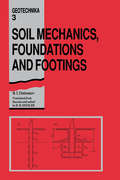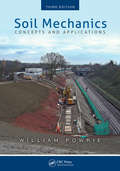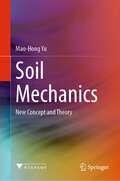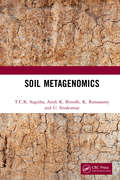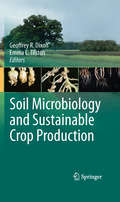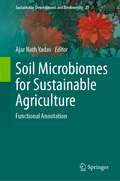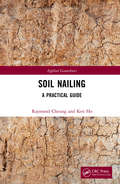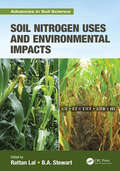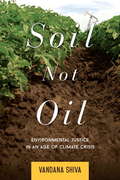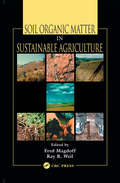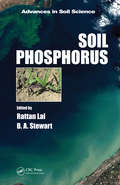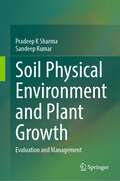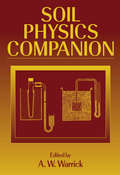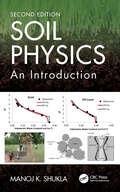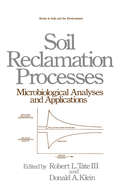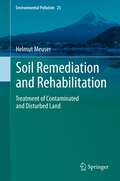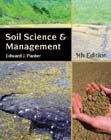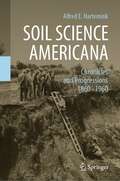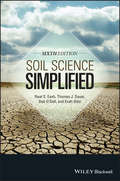- Table View
- List View
Soil Liquefaction: A Critical State Approach, Second Edition (Applied Geotechnics)
by Mike Jefferies Ken BeenA Rigorous and Definitive Guide to Soil LiquefactionSoil liquefaction occurs when soil loses much of its strength or stiffness for a time-usually a few minutes or less-and which may then cause structural failure, financial loss, and even death. It can occur during earthquakes, from static loading, or even from traffic-induced vibration. It occurs w
Soil Management and Greenhouse Effect (Advances in Soil Science #6)
by B.A. Stewart John M. Kimble Elissa R. LevineSoil Management and Greenhouse Effect focuses on proper management of soils and its effects on global change, specifically, the greenhouse effect. It contains up-to-date information on a broad range of important soil management topics, emphasizing the critical role of soil for carbon storage. Sequestration and emission of carbon and other gases are examined in various ecosystems, in both natural and managed environments, to provide a comprehensive overview. This useful reference includes chapters that address policy issues, as well as research and development priorities. The material in this volume is valuable not only to soil scientists but to the entire environmental science community.
Soil Management of Smallholder Agriculture (Advances in Soil Science)
by Rattan Lal B. A. StewartNearly two billion people depend on hundreds of millions of smallholder farmers for food security. Yet, these farmers' lives also hang in the balance due to their extreme vulnerability to the risks of soil degradation and depletion, soil exhaustion, climate change, and numerous biotic and abiotic stresses. Soil Management of Smallholder Agriculture
Soil Management: Problems and Solutions
by Michael A Fullen John A CattThe soil is a fundamental constituent of the Earth's system, maintaining a careful state of equilibrium within the biosphere. However, this natural balance is being increasingly disturbed by a variety of anthropogenic and natural processes, leading to the degradation of many soil environments. Soil Management provides a comprehensive and authoritative introduction to the many problems, challenges and potential solutions facing soil management in the twenty-first century. Covering a range of topics, including erosion, desertification, salinization, soil structure, carbon sequestration, acidification and chemical pollution, the book also develops a prognosis for the future of soil management in the face of growing populations and global warming.Written with the needs of students in mind, each chapter provides a broad overview of a problem, analyses approaches to its solution and concludes with references and suggestions for further reading. Soil Management will be of great value to environmental science and geography undergraduates taking soil management courses in their second or third year.
Soil Mechanics Fundamentals and Applications
by Isao Ishibashi Hemanta HazarikaHow Does Soil Behave and Why Does It Behave That Way?Soil Mechanics Fundamentals and Applications, Second Edition effectively explores the nature of soil, explains the principles of soil mechanics, and examines soil as an engineering material. This latest edition includes all the fundamental concepts of soil mechanics, as well as an introduction to
Soil Mechanics Through Project-Based Learning
by Dong-Sheng Jeng Ivan Gratchev Erwin OhThe currently available soil mechanics textbooks explain theory and show some practical applications through solving abstract geotechnical problems. Unfortunately, they do not engage students in the learning process as students do not "experience" what they study. This book employs a more engaging project-based approach to learning, which partially simulates what practitioners do in real life. It focuses on practical aspects of soil mechanics and makes the subject "come alive" through introducing real world geotechnical problems that the reader will be required to solve. This book appeals to the new generations of students who would like to have a better idea of what to expect in their employment future. This book covers all significant topics in soil mechanics and slope stability analysis. Each section is followed by several review questions that will reinforce the reader’s knowledge and make the learning process more engaging. A few typical problems are also discussed at the end of chapters to help the reader develop problem-solving skills. Once the reader has sufficient knowledge of soil properties and mechanics, they will be offered to undertake a project-based assignment to scaffold their learning. The assignment consists of real field and laboratory data including boreholes and test results so that the reader can experience what geotechnical engineering practice is like, identify with it personally, and integrate it into their own knowledge base. In addition, some problems include open-ended questions, which will encourage the reader to exercise their judgement and develop practical skills. To foster the learning process, solutions to all questions are provided to ensure timely feedback.
Soil Mechanics, Footings and Foundations: Geotechnika - Selected Translations of Russian Geotechnical Literature 3
by B.I. DalmatovTranslated from the second Russian edition of 1988. Parts 2, "Soil mechanics" and 3, "Foundations and footings" are revised and updated versions of the first Russian edition of 1981. Part 1, "Special course in engineering geology," contains a discussion of physicomechanical properties of soil, geody
Soil Mechanics: Concepts and Applications, Third Edition
by William PowrieInstead of fixating on formulae, Soil Mechanics: Concepts and Applications, Third Edition focuses on the fundamentals. This book describes the mechanical behaviour of soils as it relates to the practice of geotechnical engineering. It covers both principles and design, avoids complex mathematics whenever possible, and uses simple methods and ideas to build a framework to support and accommodate more complex problems and analysis. The third edition includes new material on site investigation, stress-dilatancy, cyclic loading, non-linear soil behaviour, unsaturated soils, pile stabilization of slopes, soil/wall stiffness and shallow foundations. Other key features of the Third Edition:• Makes extensive reference to real case studies to illustrate the concepts described• Focuses on modern soil mechanics principles, informed by relevant research• Presents more than 60 worked examples • Provides learning objectives, key points, and self-assessment and learning questions for each chapter• Includes an accompanying solutions manual for lecturersThis book serves as a resource for undergraduates in civil engineering and as a reference for practising geotechnical engineers.
Soil Mechanics: New Concept and Theory
by Mao-Hong YuThis book focuses on the unified solutions and analysis for the problems in soil mechanics based on the unified strength theory, which is a new theory on the yield and failure of materials under multi-axial stresses. Then, it provides a system of yield and failure criteria adopted for most materials, from metallic materials to rocks, concretes, soils, polymers, etc. It includes the Tresca criterion, Mohr–Coulomb theory, and Mises criterion as well, which are special cases or linear approximation of the UST.
Soil Metagenomics
by T.C.K. Sugitha Asish K. Binodh K. Ramasamy U. SivakumarThis book focuses on the recent advents and technological breakthroughs in metagenomic approaches coupled with their applications in agriculture. The intended audience include soil and environmental microbiologists, molecular biologists and policy makers. The book expertly describes the latest fourth generation metagenomic technologies from sample collection to data analysis, metatranscriptomic, metaproteomic and metabolomics studies Note: T& F does not sell or distribute the Hardback in India, Pakistan, Nepal, Bhutan, Bangladesh and Sri Lanka.
Soil Microbiology and Sustainable Crop Production
by Geoffrey R. Dixon Emma L. TilstonSoils into which crop plants root and from which they obtain essential minerals and water contain huge arrays of microbes. Many have highly beneficial effects on crop growth and productivity, others are pathogens causing diseases and losses to yield and quality, a few microbes offer protection from these pathogenic forms and others have little or no effect. These intimate and often complex inter-relationships are being explored with increasing success providing exciting opportunities for increasing crop yields and quality in sustainable harmony with the populations of beneficial soil microbes and to the detriment of pathogens. This book explores current knowledge for each of these aspects of soil microbiology and indicates where future progress is most likely to aid in increasing crop productivity by means which are environmentally benign and beneficial.
Soil Microbiomes for Sustainable Agriculture: Functional Annotation (Sustainable Development and Biodiversity #27)
by Ajar Nath YadavThis book encompasses current knowledge of soil microbiomes and their potential biotechnological application for plant growth, crop yield, and soil health under the natural as well as harsh environmental conditions for sustainable agriculture. The microbes are ubiquitous in nature. The soil is a natural hotspot of the soil microbiome. The soil microbiome plays a critical role in the maintenance of global nutrient balance and ecosystem functioning. The soil microbiomes are associated with plant ecosystems through the intense network of plant–microbe interactions. The microbes present in bulk soil move toward the rhizospheric region due to the release of different nutrients by plant systems. The rhizospheric microbes may survive or proliferate in rhizospheric zone depending on the extent of influences of the chemicals secreted into the soil by roots. The root exudates contain the principal nutrients factors (amino acids, glucose, fructose, and sucrose). The microbes present in rhizospheric region have capabilities to fix atmospheric nitrogen, produce different phytohormones, and solubilize phosphorus, potassium, and zinc. The plant systems take these nutrients for their growth and developments. These soil and plant associated microbes also play an important role in protection of plants from different plant pathogenic organisms by producing different secondary metabolites such as ammonia, hydrogen cyanide, siderophores, and hydrolytic enzymes. The soil microbiomes with plant growth-promoting (PGP) attributes have emerged as an important and promising tool for sustainable agriculture. The soil microbiomes promote the plant growth and enhance the crop yield and soil fertility via directly or indirectly different plant growth-promoting mechanism. The soil microbes help the plant for adaptation in extreme habitats by mitigating the abiotic stress of high/low temperatures, hypersalinity, drought, and acidic/alkaline soil. These PGP microbes are used as biofertilizers/bioinoculants to replace the harmful chemical fertilizers for sustainable agriculture and environments.The aim of the book “Soil Microbiomes for Sustainable Agriculture” is to provide the recent advances in mechanisms of plant growth promotion and applications of soil microbiomes for mitigation of different abiotic stresses in plants. The book is useful to scientists, researchers, and students related to microbiology, biotechnology, agriculture, molecular biology, environmental biology, and related subjects.
Soil Nailing: A Practical Guide
by Ken Ho Raymond CheungSoil nailing is an in situ soil reinforcement technique that can be used to enhance the stability of slopes, retaining walls, embankments, and excavations. It involves installation of closely spaced, relatively slender unstressed tension-carrying structural elements into the ground to stabilize the soil mass. These elements, which are called soil nails, comprise steel or other engineering materials such as fiber reinforced polymer. Soil nailing did not gain popularity until the 1970s when engineers started to realize that the technique could offer an effective, robust, and economical reinforcing system for a variety of ground conditions. More importantly, the track record has been excellent in that no major collapses have been reported in properly designed and well-constructed soil nailed structures so far. Considerable experience and knowledge of the technique have been gained in the past few decades through systematic technical development work comprising laboratory tests, numerical modeling, physical modeling, site trials and field monitoring covering design, and construction practices. Soil Nailing: A Practical Guide consolidates the experience and advances made in the development and use of the soil nailing technique and encourages a wider adoption of the technique by practitioners. The book is intended for use by postgraduate students, researchers, and practicing civil and geotechnical engineers, who wish to have a more in-depth and fundamental understanding of the theory and practice behind the technique. It presents the basic principles of the technique as well as state-of-the-art knowledge and recommended standard of good practice in respect of design, construction, monitoring, and maintenance of soil nailed structures.
Soil Nitrogen Uses and Environmental Impacts (Advances in Soil Science)
by Rattan Lal B. A. StewartNitrogen (N) is potentially one of the most complex elements on the Earth. It is necessary for all biological activity, but creates negative impacts on water and air quality. There is a balancing act between deficiency and surplus and the forms of N available further complicate our understanding of the dynamics. Biological fixation provides some plants with N supply while others are totally dependent upon N being available in the soil profile for the roots to extract. Nevertheless, the demand for N will increase because the human population with its increasing growth requires more protein and thus more N. Understanding the global N cycle is imperative to meeting current and future nitrogen demands while decreasing environmental impacts. This book discusses availability, production, and recycling of N in air, water, plants, and soils. It features information on N impacts to soil and water quality, management of N in agroecosystems, and techniques to maximize the use efficiency while minimizing the risks of leakage of reactive N into the environment. This volume in the Advances in Soil Science series is specifically devoted to availability, production, and recycling of N with impact on climate change and water quality, and management of N in agroecosystems in the context of maximizing the use efficiency and minimizing the risks of leakage of reactive N (NO-3, N¬2O) into the environment.
Soil Not Oil
by Vandana ShivaIn Soil Not Oil, Vandana Shiva explains that a world beyond dependence on fossil fuels and globalization is both possible and necessary. Condemning industrial agriculture as a recipe for ecological and economic disaster, Shiva champions the small, independent farm: their greater productivity, their greater potential for social justice as they put more resources into the hands of the poor, and the biodiversity that is inherent to the traditional farming practiced in small-scale agriculture. What we need most in a time of changing climates and millions who are hungry, she argues, is sustainable, biologically diverse farms that are more resistant to disease, drought, and flood. "The solution to climate change," she observes, "and the solution to poverty are the same." Soil Not Oil proposes a solution based on self-organization, sustainability, and community rather than corporate power and profits.
Soil Organic Matter in Sustainable Agriculture (Advances In Agroecology Ser.)
by Fred Magdoff Ray R. WeilRecognition of the importance of soil organic matter (SOM) in soil health and quality is a major part of fostering a holistic, preventive approach to agricultural management. Students in agronomy, horticulture, and soil science need a textbook that emphasizes strategies for using SOM management in the prevention of chemical, biological, and physic
Soil Phosphorus (Advances in Soil Science)
by Rattan Lal B. A. StewartPhosphorus is an essential plant nutrient, but global population growth has dramatically reduced the availability of phosphorus fertilizer resources. Despite this scarcity, there remain numerous problems associated with the excessive and inappropriate use of phosphorus leading to non-point source pollution and eutrophication of natural waters. Identifying appropriate systems for managing soil phosphorus and reducing the risks of eutrophication are needed to minimize the environmental risks. This book focuses on the availability and recycling of phosphorus; regulatory and policy issues of sustainable phosphorus use; and water quality management in agroecosystems pertaining to phosphorus. Sections are dedicated to global phosphorus reserves; cycling and pathways of phosphorus; phosphorus in agriculture; human dimensions and policy intervention; and research and development priorities. Phosphorus is a finite but crucial resource and is an essential element to all life. Sub-optimal availability and nutrient imbalance in the root zone can adversely impact plant growth, and the quality of food and feed grown on these soils. However, the proven reserves of phosphorus can hardly be adequate for a few centuries only. Yet, its misuse and mismanagement has caused severe problems of eutrophication of water and pollution of the environment. Thus, judicious management of soil phosphorus is essential. This volume is specifically devoted to availability and recycling of phosphorus, regulatory/policy issues of sustainable use of phosphorus, and management in agroecosystems in the context of maximizing the use efficiency and minimizing the environmental risks of water quality.
Soil Physical Environment and Plant Growth: Evaluation and Management
by Sandeep Kumar Pradeep K SharmaThis textbook on the applied aspects of soil physics covers introduction to soil physical properties and processes, and their evaluation and management in relation to plant growth. It distinguishes physical properties that directly influence plant growth from those that indirectly affect agricultural productivity. Chapters are also devoted to the concept of soil health and the role of soil physics on preservation of soil health and environmental quality. As such, this book fills a unique knowledge gap for agriculture and agronomy students, course directors as well as field professionals.
Soil Physics Companion
by A. W. WarrickAn authoritative reference on soil physics, Soil Physics Companion is lavishly illustrated with graphs, charts, line drawings, and equations. The book provides a valuable source of material and reference for most contemporary topics of soil physics and the vadose zone - arguably the most comprehensive volume available. In addition to being a reliab
Soil Physics: An Introduction, Second Edition
by Manoj K. ShuklaDesigned for undergraduate and graduate students interested in learning basic soil physics and its application to environment, soil health, water quality and productivity, this book provides readers with a clear coverage of the basic principles of water and solute transport through vadose zone, the theory behind transport and step-by-step guidance on how to use current computer models in the public domain along with soil erosion and contaminant remediation. Students will develop a deeper understanding of the fundamental processes within the soil profile that control water infiltration, redistribution, evapotranspiration, drainage, and erosion. The updated second edition features one new chapter, highlighting new problems, new computer models, and remediation. Features Serves as the most up-to-date textbook on soil physics available. Includes one new chapter and many new numerical examples. Offers mathematical descriptions supported by simplified explanations. Provides case studies and step-by-step guidance on how to use public domain computer models. Covers all principles and processes in an easy-to-understand format with numerous illustrations and sample problems. Students studying in the fields of Soil Science, Environment Science, Natural Resources, Agriculture Engineering, Civil Engineering, Environmental Engineering, Range Sciences, Horticulture, Crop Sciences, and Forestry, will find this book provides a solid foundation for their studies. Professionals, researchers, academicians, and companies working in fields related to Environmental Science, Soil Physics, Hydrology, and Irrigation, will find this book is a great reference tool as it is the most up to date in its field.
Soil Reclamation Processes Microbiological Analyses and Applications
by Robert L. Tate Donald A. KleinThis book provides an assessment of the understanding of soil microbiology and biochemistry as part of reclamation processes. It attempts to assemble more specialized literature on reclamation, where application of microbiological concepts has provided the understanding of the process.
Soil Remediation and Rehabilitation
by Helmut MeuserThis book provides a comprehensive overview of remediation and rehabilitation techniques and strategies for contaminated and anthropogenically disturbed land. Rehabilitation approaches in the urban environment, such as brownfield redevelopment and urban mining, are discussed. In relation to contaminated land, techniques for soil containment and decontamination of soil, soil vapour and groundwater are comprehensively and systematically presented. Complicated treatment techniques are schematically depicted and can be readily understood. Agricultural, silvicultural and environmentally sustainable rehabilitation strategies for reclaiming disturbed land/terrain in former mining or natural-resource extraction areas, such as open-cast mines, quarries, harvested peatlands, and subsided mining terrain (sinkholes), are introduced. This book will be a useful tool for students, researchers, private consultants and public authorities engaged in the treatment of contaminated or disturbed land.
Soil Science & Management
by Edward J. PlasterThis textbook overviews the principles of biology and chemistry relevant to understanding the processes of soil formation and its management by farmers, horticulturists, and conservationists. Topics include the physical properties of soil, drainage and irrigation, plant nutrition, and amendments. The fourth edition updates data on national soil usage and erosion rates, and adds a section on human alteration of nitrogen cycles. Annotation (c)2003 Book News, Inc. , Portland, OR (booknews. com)
Soil Science Americana: Chronicles and Progressions 1860─1960
by Alfred E. HarteminkThis book narrates how the study of the soil became a science and institutionalized in the USA between 1860 and 1960. The story meanders through the activities, ideas, publications, and correspondence of people who influenced the progressions, that led to the budding and early blossoming of American and international soil science. Interwoven is a tale of two farm boys who grew up 900 km apart in the Midwest USA in the late 1800s and early 1900s. Emil Truog and Charles Kellogg met in the late 1920s and shared a natural connection to the soil. Both were practical pioneers and believed that understanding soils was crucial to helping people on the land make a better living. The USA is a big country, its soil science is geographically intertwined, and the cradle of its history primes back to a few people. “Soil Science Americana is an intellectual biography, not of one individual but of a new scientific field from its emergence to its complete coming of age.”— Louise O. Fresco, President, Wageningen University and Research“In a lively, personal voice, Hartemink traces the roots of modern soil science in the United States…creating a book that will engage both the expert and non-expert in the underappreciated field of soil science.”— Jo Handelsman, Director, Wisconsin Institute for Discovery“The intellectual master piece is of interest to soil scientists, general public and the policy makers, and will remain pertinent for generations to come.”— Rattan Lal, World Food Prize Laureate 2020, The Ohio State University
Soil Science Simplified
by Thomas J. Sauer Aga Razvi Neal Eash Forbes WalkerAlready renowned as a user-friendly beginners' guide to soil science, Soil Science Simplified, 6th Edition is an updated version of the beloved textbook that includes even more thorough applications of soil science to interdisciplinary fields. It includes the most recent research concerning uses of soil in municipal, engineering, and other areas, conversion agriculture covering no-till, hoe-till, and the methodology of cover crops, crop rotations, N contribution, and worldwide trends in conversion agriculture. The experienced authors have fully revised and updated the fundamental chapters on physical, chemical, and biological properties to create an ideal introductory text.
